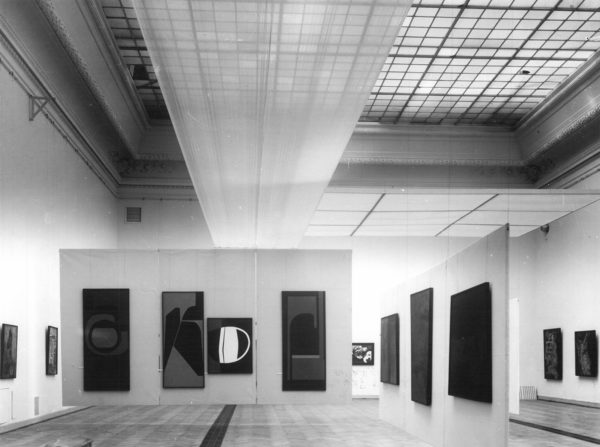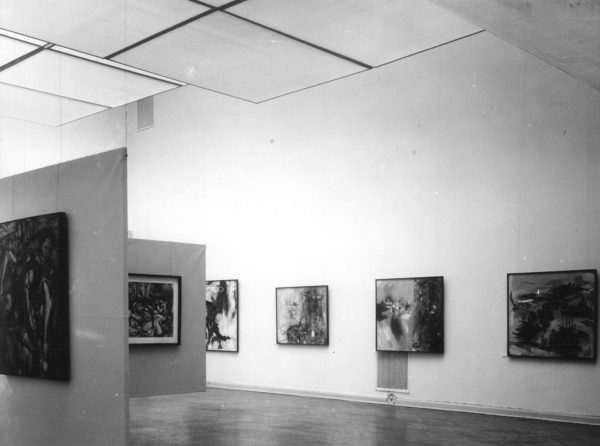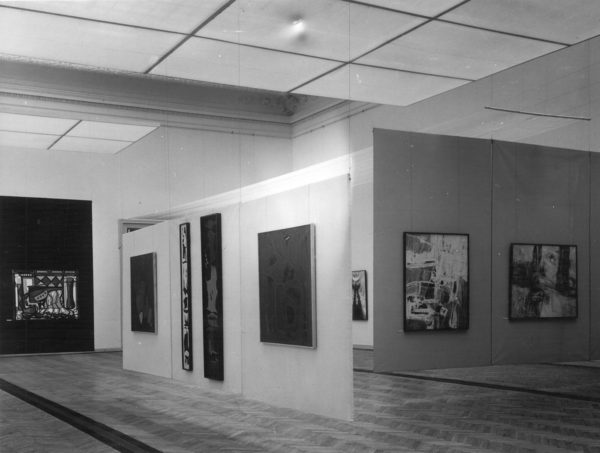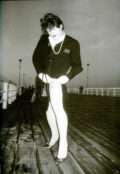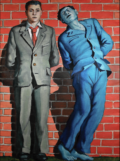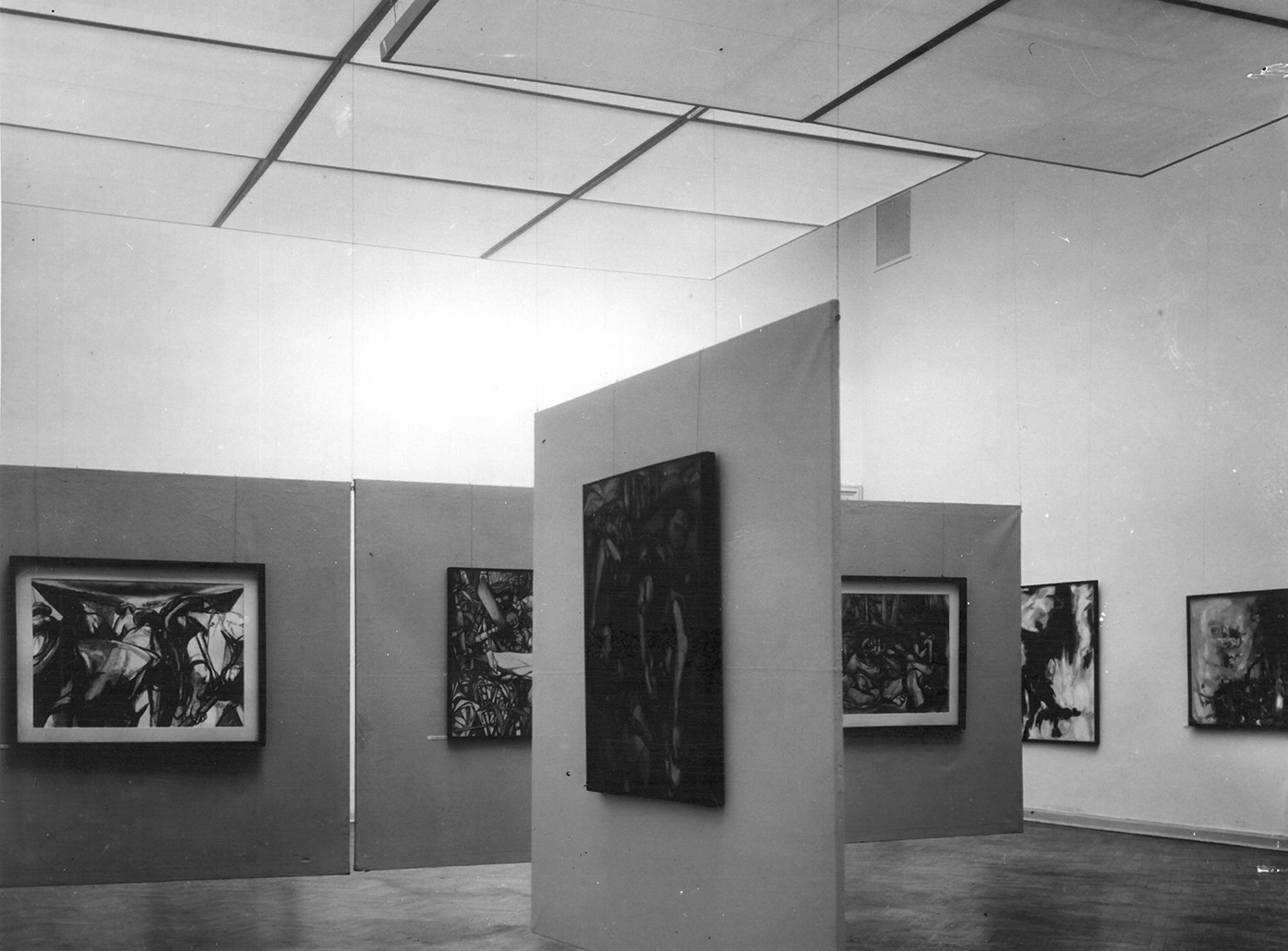
Title
“Like Fidel at a Rally in Havana”: Warsaw’s Exhibition of Cuban Painting with a Global Political Crisis in the Background (1962) Warszawska „Wystawa malarstwa kubańskiego” z globalnym kryzysem politycznym w tle (1962)
https://www.doi.org/10.48285/PSWPAWCSPR
http://miejsce.asp.waw.pl/en/jak-fidel-na-wiecu-w-hawanie/
Abstract
”Exhibition of Cuban Painting”, created by the National Council for Culture in Cuba and the National Union of Writers and Artists of Cuba, opened on October 9, 1962 at the Central Office of Artistic Exhibitions (CBWA) in Warsaw. Its closing date (October 28, 1962) coincided with the end of the so-called Cuban Missile Crisis (October 16–28, 1962) – the greatest political crisis in post-World War II history between superpowers in possession of nuclear weapons, caused by the secret deployment of medium-range ballistic missiles by the Soviet Union in Cuba, which posed a threat to US territory. The article seeks to interpret the reception of the exhibition of Cuban art in the Polish People’s Republic, organized within the framework of official international cultural exchange (in the Polish press, the event received several dozen reviews and mentions, which often underlined that the show presented the “art of a fighting island”), against the background of the international crisis during the Cold War. The case study proposed here sits within modern international research on the histories of exhibitions that finds its starting point in the question of their simultaneity or non-simultaneity in relation to the periodizations established in global political history.
DOI
“I like the works by the Cuban painters Gonzales and Moreno. Why? These painters are simply the most comprehensible, and yet modern (in terms of the color). They speak with their paintings like Fidel at a rally in Havana.”1 This remark was shared in the audience survey of the Central Office of Artistic Exhibitions (CBWA) in Warsaw in response to the question: “Which of the artworks presented in the exhibition do you like the most and why?” The survey concerned Exhibition of Cuban Painting, created by the National Council for Culture in Cuba and the National Union of Writers and Artists of Cuba, which opened at the Zachęta on October 9, 1962.2 The author of the remark signed it as “19-years-old – student.” This 19-year-old enthusiast of Cuban painting, which was appearing in Poland for the first time on that occasion, had probably seen Fidel Castro on television or in the Polish Film Chronicle (PKF). The broadcast aired on September 21, 1962 included coverage of demonstrations in Cuba against the policy of the United States: “Cuba is not alone. And the Cuban nation staunchly defends its revolution and freedom.”3

”Exhibition of Cuban Painting”, CBWA, Warsaw, 1962, reproductions of works by Carmelo Gonzales, Adigio Benítez, Orlando Yanes; photo from: M. S., “Lud wypuszcza gołębia do lotu,” Przyjaźń, no. 45, November 11, 1962
The impressions from the Cuban exhibition noted in 1962 by a Polish viewer offer a pretext both to bring back the memory of that exhibition as part of the timeline of Polish artistic life and to examine more closely its connection with political history. The closing date of Exhibition of Cuban Painting (October 28, 1962) coincided with the end of the so-called Cuban Missile Crisis (October 16–28, 1962) – the greatest political crisis in post-World War II history between superpowers in possession of nuclear weapons, caused by the secret deployment of medium-range ballistic missiles by the Soviet Union in Cuba, which posed a threat to US territory.
The reception of the first exhibition of Cuban art in the Polish People’s Republic, organized within a framework of cultural collaboration (an agreement between the governments of the two states was signed in March 1961), cannot be abstracted from the political background of the international crisis during the Cold War. In the Polish press, the event received several dozen reviews and mentions, which often underlined that the show presented the “art of a fighting island” and featured pieces created within the period of three years following the victory of the Cuban Revolution in 1959.4
The first exhibition of Cuban art in the Polish People’s Republic
The uniqueness of the exhibition of Cuban art at the CBWA was already being emphasized in the Polish press in July 1962, more than two months prior to the show opening: “This is going to be the first opportunity in Poland to view CONTEMPORARY CUBAN PAINTING, which is said to hold a considerable position in global art.”5 In September 1962, the press reported on the arrival of the Cuban delegation: Dr. Graziella Pogolotti, commissioner of the exhibition, art critic and historian from the University of Havana; Servando Cabrera Moreno – a painter whose works were being shown at the exhibition; and Raul Oliva – a Cuban architect, the designer of the show.6 By September, it was also highlighted that the exhibition was arriving in Warsaw from Moscow, and had previously been seen by “residents of several people’s democracy countries” (it was presented in Czechoslovakia and Hungary, among other locations).7

”Exhibition of Cuban Painting”, CBWA, Warsaw, 1962, works by Servando Cabrera Moreno; photo: Documentation Department, Zachęta – National Gallery of Art
On the day after the opening, the daily press published numerous pieces that underscored the political rank of the event. The exhibition was inaugurated by the Minister of Culture and Art Tadeusz Galiński, and the opening was attended by representatives of the Polish Ministry of Foreign Affairs (MSZ) and the Culture Department of the Central Committee of the Polish United Workers’ Party (KC PZPR), among other functionaries, as well as the abovementioned Cuban delegation (Graziella Pogolotti, Servando Cabrera Moreno and Raul Oliva), who – as we read in the catalog – “accompanied the exhibition in socialist countries.”8 A speech of greeting was delivered by Tadeusz Gronowski, the Head of the Main Board of the Association of Polish Artists and Designers (ZPAP) (the Cuban guests were received by Gronowski the following day at the ZPAP headquarters).9
As noted, the Warsaw iteration of Exhibition of Cuban Painting coincided with the Cuban Missile Crisis (October 16–28, 1962). The Polish press highlighted the significance of the show at the Zachęta throughout its duration, as well as the abundant program of the Cuban delegation’s visit to Poland. An article from October 25, 1962 reads: “A group of Cuban visual artists has been on a visit to Poland for a month [Pogolotti, Moreno, Oliva – GŚ]. […] Apart from Warsaw, they have visited Kraków, Zakopane, Nowa Huta. […] The Cuban visual artists also met a great many Polish artists. Among paintings viewed at the museum, they were highly impressed by Jan Lebenstein’s works. The Cuban guests take delight in Polish folk art. They also lavish praise on the care with which we surround folk artists.”10 It was also mentioned that the guests appreciated works by Jan Cybis, Alfred Lenica, Henryk Stażewski, Halina Chrostowska, and Alina Ślesińska.11
The exhibition witnessed a peculiar military “finissage.” On October 27, 1962, newspapers reported that the show had been viewed by the Minister of National Defense, General of Arms Marian Spychalski, accompanied by the Deputy Minister of National Defense, Chief of the Central Political Board of the Polish Military, Major General Wojciech Jaruzelski, and the Deputy Chief of the Central Political Board of the Polish Military, Brigade General Bronisław Bednarz; the Zachęta hosted a meeting between them and the chargé d’affaires of Cuba, Jose A. Perez Garcia.12 By juxtaposing these facts and dates I do not mean to suggest that the exhibition had a special “strategic military significance” in the era of the Cuban Missile Crisis; the generals also viewed Vincent van Gogh’s show at the National Museum in Warsaw the same day.13 The presence of military representatives at exhibition openings at the CBWA was nothing extraordinary, albeit it always bore relation to events of “appropriate” political rank, for example exhibitions on the occasion of round anniversaries of the Polish People’s Army or Soviet art shows. The press listed the names of the representatives of the highest party, government, or military authorities attending such openings. Yet, it was seldom the case that CBWA exhibitions were covered more than two months prior to their opening and almost a month after they had concluded.14 Analyzing the abundance of official commentaries and mentions concerning the Cuban exhibition, it is difficult to call its strategic propaganda significance into doubt.
Cuban painting in the aftermath of the revolution
Aside from biographical notes of the official delegation members and of the artists – complete with a list of the presented works and thirteen reproductions – the catalog of Exhibition of Cuban Painting also includes two introductions, signed by the National Council for Culture and the National Union of Writers and Artists of Cuba:
The decision to show the present exhibition in befriended countries was taken by the National Council for Culture with full consciousness that the selected set may prove extremely debatable. It is a faithful picture of everything that is created in Cuba today – only three years after the victory of the Revolution of January 1, 1959. Viewers will probably notice the visible influence of familiar schools and tendencies, especially the influences of Paris and New York; at the same time, they will be able to discern the first signals of a new art, an art that seeks to reflect the new reality developing despite the threatening attacks of the imperialistic neighbor.15
Published in the catalog, the statement that the set of works touring socialist countries during the Cold War for propaganda reasons may prove “debatable” requires highlighting and clarification. It was explained that the exhibition comprised art that still did not fully express the ideals of the Cuban Revolution: “[…] our contemporary painting has been seemingly dominated by abstraction, belated in our country.”16 At the same time, it was expected that “the creative tension heightened by rising national awareness will soon offer us a new art, a living and self-reliant art, an art that expresses our Revolution.”17 The importance of the year 1925 to the country’s history was brought back to memory – the date when the Communist Party of Cuba was established. It was lamented that the following years witnessed a “weakened drive to realism” in painting and other artistic disciplines, while emphasizing at the same time that artists “did not lose the domestic, Cuban character.”18 “Cuban painters never needed to resort to creating propaganda posters in order to keep abreast of the noblest pursuits of their Fatherland for 30 years” – it sufficed that they turned to landscapes and “rural themes.”19
Let us confront the propagandistic “curatorial” concept evoked above with the reality of the exhibition and its reception in the Polish People’s Republic. Filling two halls of the Zachęta edifice, the show comprised 99 pieces by 23 Cuban artists.20 What obviously recurred in the reviews published in the Polish press was the propaganda thread: the vision of art at the service of the Cuban Revolution, in line with the arguments of the organizers put forward in the catalog introduction. Among the aspects underscored by Polish critics was the significance of the propagation of art in the new Cuban reality after the revolution, whose strategies resembled some of the activities in the field of education and popularization pursued in Poland by the CBWA in the 1950s and 1960s: “[…] special teams of trained lecturers equipped with reproductions of paintings set out to Cuban villages and towns in order to teach people how to look at an artwork.”21
A probing analysis of the relations between art and the revolution was conducted by Stanisław Ledóchowski in a review published in Nowa Kultura: “The Cuban Revolution rightly interpreted the complex and intricate structure of art by not putting forward a clear program in this regard. Cuban cultural activists may have found our own experiences helpful, according to which art that wants to be an ally of the revolution must preserve its own individual face.”22 Ledóchowski and other critics were intrigued by the fact that the exhibition of Cuban art that toured socialist countries three years after the victory of the revolution did not feature works that could be deemed ideologically consistent. What was probably expected was a Cuban iteration of Socialist Realism with a universal revolutionary iconography. Meanwhile, “no forests of clenched fists nor red banner flagpoles could be seen coming out of the generally objectless paintings.”23 It was argued that “the exhibition comprises nothing of a uniform tendency or ‘manifesto’ that could be expected given the intensity of challenges faced by the artists in a country that began a cultural revolution with a mass movement towards eradicating illiteracy. We can therefore see, for instance, both abstract compositions and canvasses that bear characteristics of Cubism, as well as realist pieces that bring to mind Mexican art.”24
Let us set the critic’s surprise at the diversity of tendencies represented by Exhibition of Cuban Painting in Warsaw (including the prominent presence of abstraction) in the context of Polish artistic life in the early 1960s. April 1960 saw the formulation of the now-famous guidelines of the Secretariat of the KC PZPR concerning cultural policy in the field of the visual arts, which largely concerned the topics of exhibitions; “exhibiting realist works” and treating “abstract works […] as marginal phenomena” were both decreed on that occasion.25
Whereas the Polish exhibition policy of the era was officially informed by the recommendation to marginalize abstraction, Cuban art in the aftermath of the revolution continued to accept abstract tendencies. “I was painting in an abstract style when the revolution came in 1959. I continued in that style until about 1964. By 1963 […] I began to feel that abstraction had nothing to do with our new environment”26 – reads a statement by one of the participants of the CBWA exhibition, Raúl Martínez (1927–1995). The show at the Zachęta featured five of his abstract works: Our Land and White I–IV (a piece from that series was reproduced in the catalog).27 Notably, his work was mentioned by a visitor: “I had to view the exhibition quickly, but my attention was particularly drawn to the abstract paintings by Raúl Martínez, and they will stay in my memory for a long time.”28
New revolutionary realism
“Two tendencies should be distinguished in this country’s painting – abstractionism and realism”29. A great many reviews and mentions in the Polish press emphasized these two polar opposites in art, although more tendencies were discerned in Exhibition of Cuban Painting, such as “realism on the lookout for new forms of expression, geometric abstraction and informel.”30 Let us add that, at the same time, the CBWA also showcased more than 270 works by 25 Polish realist painters, for example Helena and Juliusz Krajewski, Jerzy Krawczyk, Antoni Łyżwański, Stanisława and Włodzimierz Panas, and Aleksander Winnicki31. Such circumstances inspired critics to draw comparisons between Polish and Cuban art, but at the same time – as if in line with party recommendations – Cuban abstraction was visually marginalized when set alongside the survey of the then-current realist tendencies in Polish art.
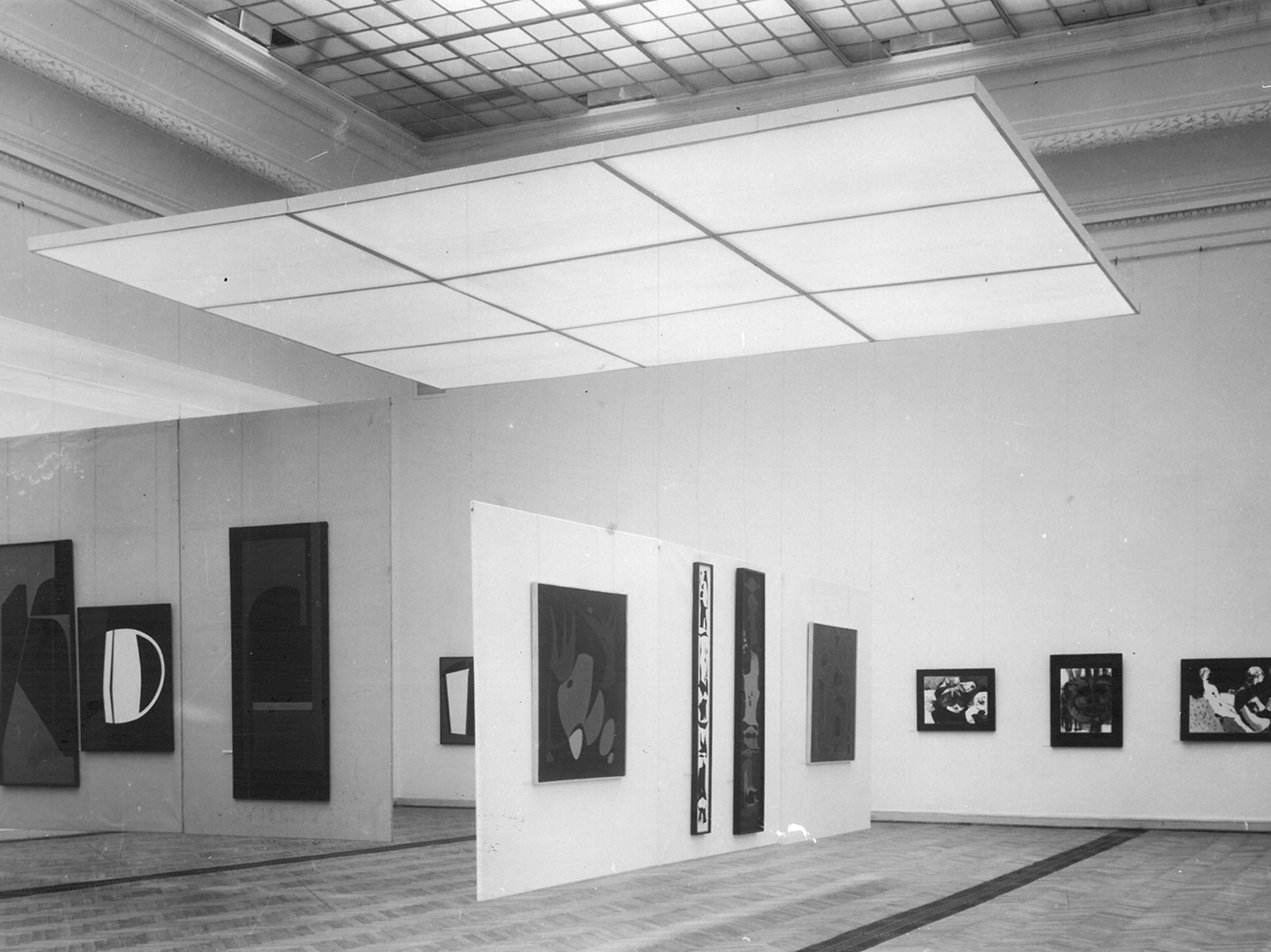
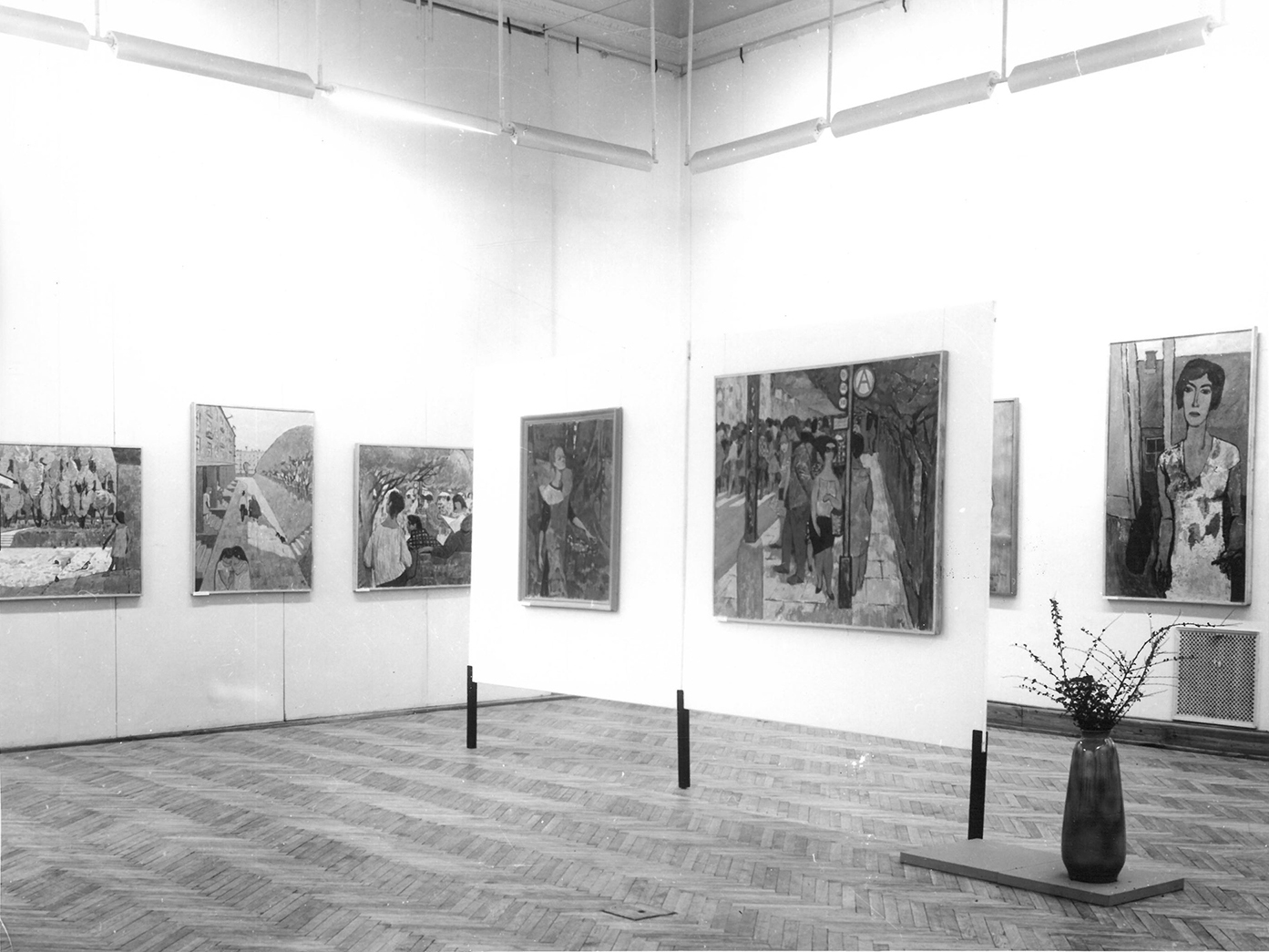
Even if the reviews abound with remarks concerning Cuban abstraction holding a dominant position in the exhibition, the most frequently reproduced paintings in the Polish press were those by Servando Cabrera Moreno (1923–1981), such as An Education Activist and a Peasant Murdered, Peasants, Peasant Militia, and Sugar Cane Harvest. Moreno, a member of the Cuban delegation, received the broadest coverage; he was the one to whom the statement from the survey quoted at the beginning referred, said to “speak with paintings like Fidel at a rally in Havana.” It was noted that “from among the realistic – figurative – works, the most interesting compositions were created by Cabrera Moreno. They are characterized by a very well-sensed, albeit vibrant color, and immense decorativeness of the gentle lines tangled to form circles […].”32 Ewa Garztecka discerned in Moreno’s works a “spiritual and formal kinship with the art of Guttuso.”33 Stanisław Ledóchowski recognized him as a “typical representative of South American art,” who bore similarity to “militant” Mexican art: “Regardless of the format of the canvasses, Moreno’s paintings are monumental; their expression relies more on the language of wall painting than easel painting. As for the manner of perceiving and interpreting the everyday reality of his country, Moreno resembles the Mexican painter José Clemente Orozco.”34 What matters in the juxtaposition of these two voices is the fact that the Polish critics evaluated Moreno’s realism against the background of exhibitions hosted by the CBWA several years before; 1954 witnessed a show by Renato Guttuso, and 1955 saw a memorable exhibition of Mexican art featuring masters of muralism and revolutionary graphic art. Mexican art, including graphic works from the circle of Taller de Gráfica Popular (People’s Graphic Workshop, a collective active since 1937), was most frequently exhibited in the Polish People’s Republic within the official exchange program with Latin American countries.35
Mexican references appeared not only in analyses of Moreno’s art, but also that of Carmelo Gonzales (1920–1990), Adigio Benítez (1924–2013), and Umberto Peña (b. 1937). As stressed in Życie Literackie, “The shadow of Mexican art can […] be found in the method of composing some of the representational paintings, with firm divisions, prominent graphic appeal, considerably filled surfaces, and exaggerated anatomical traits, as is the case, for example, in […] figural scenes by Carmelo Gonzales.”36 The same critic also associated paintings by Umberto Peña (Skinned Ox, Cow) with Mexican folk art, “its expressiveness, vision of death, and cruelty.”37
The individual style of Carmelo Gonzales was likened at the same time to compositions by Fernand Léger: “his works have […] something of poster-like simplicity and austerity of means of expression. Colors outlined with a broad contour and the compositional arrangements perhaps bear slight resemblance to works by the great French painter Léger.”38 Well-known and exhibited in Poland, Léger received a number of mentions in the critical reviews of the Cuban exhibition.39 His art and political engagement served both to bring the new Cuban realism closer to Polish viewers and to demonstrate links with European art. Léger’s influences – “dragged from Paris ateliers” – were discerned by Lew Kaltenbergh not only in works by Gonzales, but also those by Amelia Peláez (1897–1968).40 Garztecka characterized Peláez’s work in a similar way: “Légerian black contour serves the artist to outline color planes, to create a highly decorative arabesque.”41 The remarks concerning Paris ateliers were apt: Peláez – akin to other Cuban artists of her generation – had left for Paris in 1927.42
Revolutionary Mexican art, similarities to Renato Guttuso’s realism, Légerian contour – those were the threads highlighted by Polish critics as inspirations behind the new revolutionary Cuban realism, which was clearly distinguished from the 19th-century academic tradition. As emphasized by Elżbieta Sztekker, who agreed with the statements published in the exhibition catalog, “A considerable return to realism makes itself manifest in the aftermath of the revolution of 1959, although it is no longer the old academic style, but a new, fermenting realism that approaches the new revolutionary reality emotionally.”43 Yet, a question emerges as to how – in the light of the postulates of new, non-academic Cuban realism – the Polish People’s Republic managed to explain the presence of abstraction and the influence of other avant-garde tendencies on Cuban art.
Abstractions and other avant-gardes between Latin America and Europe
Let us return to the voice of the critic who fully appreciated the diversity of tendencies presented in the Exhibition of Cuban Painting in 1962: “The exhibition […] may not necessarily feature great talents, but there is excellent, life-giving, intellectual ‘gymnastics’; there is a sowing that fertilizes the soil. And so we find there almost all currents that exist nowadays. From extreme ‘Unistic’ abstraction to ‘critical’ realism with a socio-political edge. […] its polemical, confrontational character merits great recognition and a hearty recommendation.”44
The use of the term “Unistic” with regard to Cuban abstraction is particularly intriguing, not only given the Polish context – the rehabilitation of Władysław Strzemiński in the aftermath of the political “thaw.” In 1956, an exhibition of his and Katarzyna Kobro’s works was held in Łódź, later shown at the CBWA in January 1957. These events led to the presentation of works by Polish abstract artists, Précurseurs de l’art abstrait en Pologne: Malewicz, Kobro, Strzemiński, Berlewi, Stażewski at the Denise René Gallery in Paris, between November 1957 and January 1958.45 The exhibition, whose opening attracted a crowd of representatives of French artistic life (e.g. Louis Aragon, Tristan Tzara, Jean Cassou, and Jean-Paul Sartre), was also viewed by Alejo Carpentier, the Cuban writer and communist, who was known as an advocate of abstraction. Dividing his time between Paris and Cuba since 1927 (where he returned to for longer in 1959), Carpentier became “filled with enthusiasm for the minimalist painting of the Polish Unists (Strzemiński, Stażewski) exhibited by the Denise René Gallery.”46
Apart from new realism, critics devoted most attention to the Cuban abstract currents, particularly geometric abstraction. Ewa Garztecka’s review mentions no less than five Cuban abstractionists:
Geometric abstraction, various forms of constructivism received a new lease of life in Ibero-Latin American art. Progressive political elements became entwined here with visual-arts principles, because new geometric abstraction develops from the need to seek and establish harmony and a new order based on intellectual premises. This tendency is abundantly represented in Cuban art. Pure, balanced geometric planes in black, white, and brown in paintings by Salvador Corratgé, clear-cut divisions in pieces by Luís Martínez Pedro and José Mijares, rhythms expressive of movement that flash before the eyes in Sandú Darie’s art – all offer examples. In turn, Pedro de Oraá still fills planes with uniform color, but his forms become more organic or transform into rhythms of signs.47
Let us add that Salvador Corratgé (1927–2014), Luís Martínez Pedro (1910–1989), José María Mijares (1921–2004), Romanian-born Sandú Darie (1908–1991), and Pedro de Oraá (b. 1931) were members of the group Los Diez Pintores Concretos, active in Havana from 1958 to 1961. Cuban representatives of concrete art – a tendency that also characterized the art of Brazil and Argentina in the 1950s and 1960s – have recently been revisited in the exhibition Concrete Cuba, organized by David Zwirner Gallery in London and New York (2015–2016).48 Another Polish critic was most appreciative of the abstract works by Hugo Consuegra (1929–2003), observing that “spatial solutions in the spirit of Mondrian’s art continue to function as a topical means of expression for many Cuban painters. However, it seems that this hardly impassioned type of rather speculative painting is already heading into decline.”49
The Polish press published a number of reproductions of works by René Portocarrero (1912–1985), e.g. Gray Figures I–II50. These were compared to the art of Rajmund Ziemski and situated within the informel tendency: “The exhibition features many abstract works in which the patch and the line, developed freely according to the principles of Tachisme, play an essential role.”51 Notably, Portocarrero and another participant of the CBWA exhibition, Raul Milian (1914–1986), soon returned to the halls of the Zachęta for their joint exhibition organized in September 1963.52 Portocarrero’s compositions (Carnivals) were also shown at the CBWA in April 1979, as well as in the Zachęta exhibition Contemporary Cuban Painting in February of the same year.53
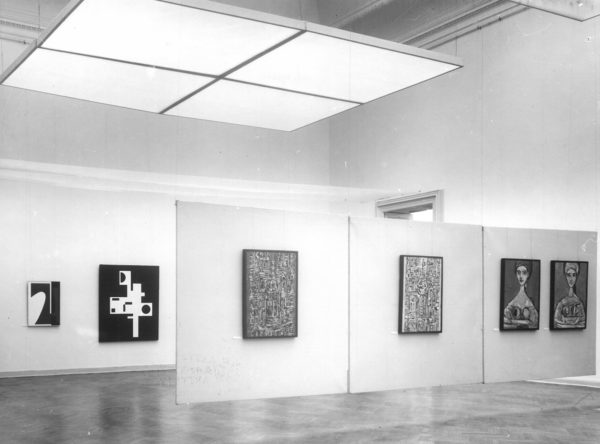
”Exhibition of Works by 25 Realist Painters”, CBWA, Warsaw, 1962, works by René Portocarrero (Gray Figures I–II, among other pieces); photo: Zachęta – National Gallery of Art
In 1962, critics took note of the presence of informel in the Cuban exhibition; however, it was reported on much less enthusiastically than the realism and concrete abstraction. Works by Mariano Rodríguez (1912–1990) and Juan Tapia Ruano (1914–1980)54 were noticed, but the general tendency was described as “highly advanced aestheticism under the banner of the abundantly nuanced and purely visual school of Paris textural painting.”55 A greater interest was stirred by the work of Antonia Eiriz (1929–1995), whose ink drawings were recognized as an interesting continuation of the European expressionist tradition,56 and by the only Surrealist artist in the exhibition, Ángel Acosta León (1930–1964).57
Among the voices that distinguish the “influences” of European art, we find some that disparage Cuban art as not being exactly original: “Formally speaking, Cuban painting does not introduce […] any revelatory distinctive qualities or discoveries. Everything we are shown has already been done and has been known for decades – late Colorism, geometric abstraction originating from the canons of De Stijl, Surrealism, soft and textural abstraction.”58 Conversely, critics admired the “immense mobility” of Cuban artists – “both in the sense of organizing exhibitions abroad and of artistic voyages.”59 Considerable rhetorical effort was also invested in lending legitimacy to Cuban abstraction in the Polish context. As Kaltenbergh argued in his review titled “Sztuka walczącej wyspy” [Art of the Fighting Island], “[…] what strikes us is the tendency of ideological subservience manifested by this art, regardless of whether it is more realistic or approaches abstraction. […] And perhaps this harnessing of the abstract manner for social service is the most important characteristic of the current inquiries and experiments of the painters’ milieu in Cuba.”60
Summary: geographic flows and historical non-simultaneities
Artistic contacts between Eastern Europe and Cuba “were limited to the official exchange of delegations and rather boring – equally official – exhibitions,”61 as Piotr Piotrowski commented on the situation in the 1980s in his last book, which remained an unfinished project. I evoke Exhibition of Cuban Painting in 1962 because of the extraordinary political circumstances of its display at the CBWA during the Cuban Missile Crisis and at the beginning of official cultural cooperation between the Polish People’s Republic and the Republic of Cuba, but also in connection with the presentation of many tendencies in Cuban art and its reception in the Polish press. Beyond doubt, the exhibition was an official event, but – given both the selection of works and the history of its reception – it was not necessarily “boring” or unworthy of scholarly reflection. The case study proposed here sits within modern international research on the histories of exhibitions that finds its starting point in both the question of redefining the geography of art and in the problem of time and temporality, for example the simultaneity or non-simultaneity of exhibitions as socio-artistic events in relation to the periodizations established in art history or in global political history.62
On the basis of the available data (e.g. published exhibition timelines and the Central Exhibition Plans preserved in the archive of the Zachęta and implemented by the CBWA in the 1960s and 1970s), it may be stated that the exhibition of Cuban art in 1962 was one of the events that initiated the intensive cultural exchange between the Polish People’s Republic and the Republic of Cuba. Cuban art was presented again at the CBWA in group exhibitions in 1976 (Painting and Graphic Art of Cuba), in 1979 (the abovementioned Contemporary Cuban Painting), and in 1988 (Cuban Graphic Art from the 17th to the 20th Century from the Collection of the National Museum in Havana). Alejo Carpentier (already noted as an enthusiast of Polish abstraction), whose novels were translated into Polish in the 1960s and 1970s (The Lost Steps as Podróż do źródeł czasu, Explosion in a Cathedral as Eksplozja w katedrze), authored prefaces to catalogs of Cuban art.63 The documentation of the exhibition in 1979 has preserved a summary of the cultural cooperation between the Polish People’s Republic and Cuba, initiated by a government agreement signed in 1961:
Detailed plans of the implementation of the agreement were signed every two years. The last “Cultural Cooperation Program,” signed on March 2, 1976, is the first one to embrace a period of five years: 1976–1980. Nineteen years is not long as concerns the traditions of cultural cooperation, but as for Polish-Cuban relations, that period is long enough to allow for serious achievements in the field. […] 26 Cuban artistic exhibitions were organized in Poland, and 22 exhibitions of Polish art were hosted in Cuba.64
Cultural exchange embraced not only art exhibitions, but also performances by dance, vocal, and theater groups, film screenings, and publishing collaborations (for example, a translation of Władysław Reymont’s The Peasants was released in Cuba in 1976). It was not by chance that the organization of artistic events coincided with political anniversaries: the Days of Cuban Culture organized in April 1976 in twelve Polish cities were meant to celebrate “the fifteen years of cultural cooperation between the Polish People’s Republic and the Republic of Cuba and the fifteenth anniversary of the victory of the Cuban armed forces in the controversial Bay of Pigs invasion (Playa Girón) on April 19, 1961.”65
The exchange of exhibitions between the Polish People’s Republic and non-European countries is a field that requires in-depth art-historical studies.66 Exhibition of Cuban Painting in 1962, which is perceived as one of many events organized within the framework of official cultural exchange, provides the possibility of reworking the geographical research perspective and redefining the directions of inspiration flows between countries from behind the Iron Curtain and Latin America during that era, in which the role of the cultural hub (in art history) was still being played by Paris, Moscow, and New York, but also by the São Paulo Biennial, organized since 1951. Let us also add that Cuban art should be recognized, alongside Mexican art, as the most frequently showcased at the CBWA; other Latin American countries never became the topic of thorough group survey exhibitions. Yet, individual shows were held, for instance of the Brazilian abstract artist Almir Mavignier, co-organizer of the first New Tendencies exhibition in Zagreb in 1961 (CBWA, 1967),67 and of the communist-leaning Ecuadorian painter Oswaldo Guayasamin, whose works were shown at the Zachęta in 1983.68
One of the traditional ways of embracing relations between political history and art history involves perceiving the periodization of the former as a significant background against which art history positions individual artworks and artistic events. Simultaneously, a currently pursued debate concerns the concept of the “heterogeneity” of the artwork’s time and the “non-simultaneities” – the mutually overlapping or shifting “layers of time” of political history and art history.69 The first Cuban exhibition was shown in Warsaw at the time of the official “marginalization” of abstraction in exhibition policies. A matter of particular importance in this context is the history of the reception of the show in the Polish People’s Republic, when the Socialist Realist chapter had already been closed, although realist tendencies were still officially favored (from 1962, the CBWA held annual group exhibitions of realist artists). A certain image of Exhibition of Cuban Painting emerges from the press reproductions of selected works (mostly realist, figurative pieces), while a slightly different vision can be formed on the basis of the preserved photographs of the exhibition (which depict geometric abstraction and Cuban concrete art). Among its other aspects, the temporal, art-historical paradox consists of the fact that a touring exhibition – meant to propagate the art of the young Republic of Cuba – showcased many abstract works, inspired by European avant-garde tendencies, while Poland had expected the revolutionary art of “clenched fists” and “red banners.”70
Bibliography
A. K. “Sztuka Kuby.” Dziennik Bałtycki, no. 269, November 12, 1962.
Bazin, Jérôme, Pascal Dubourg Glatigny, Piotr Piotrowski, eds. Art beyond Borders: Artistic Exchange in Communist Europe (1945–1989). Budapest–New York: Central European University Press, 2016.
CBWA, ed. Wystawa malarstwa kubańskiego. Warsaw: Centralne Biuro Wystaw Artystycznych, 1962.
(ega). “Otwarcie wystawy sztuki kubańskiej.” Trybuna Ludu, no. 28, October 10, 1962.
Fernandez, Segundo J., Juan A. Martínez, Paul Niell. Cuban Art in the 20th Century: Cultural Identity and the International Avant-Garde. Tallahassee FL: FSU Museum of Fine Arts, 2016.
Fusco, Coco, Robert Knafo. “Interviews with Cuban Artists.” Social Text, no. 15 (1986): 41–53.
(g). “Malarstwo Kuby i inne wystawy zobaczymy w Zachęcie.” Kurier Polski, no. 171, July 20, 1962.
Gałczyńska, Kira. “Malarstwo dzisiejszej Kuby.” Kurier Polski, no. 250, October 20–21, 1962.
Garztecka, Ewa. “Współczesne malarstwo kubańskie.” Trybuna Ludu, no. 291, October 20, 1962.
Hackiewiczowa, Wanda, Maria Matusińska, Barbara Mitschein, Ada Potocka, Halina Zacharewicz, eds. Rocznik CBWA 1962. Warsaw: Centralne Biuro Wystaw Artystycznych, (1963).
Hackiewiczowa, Wanda, Maria Matusińska, Barbara Mitschein, Ada Potocka, Halina Zacharewicz, eds. Rocznik CBWA 1963–1964. Warsaw: Centralne Biuro Wystaw Artystycznych, (1965).
(i). “Malarstwo kubańskie i polskie w Zachęcie.” Głos Pracy, no. 242, October 10, 1962.
“Jak malują na Kubie.” ITD. Ilustrowany Magazyn Studencki, no. 46, November 18, 1962.
Kaltenbergh, Lew. “Sztuka walczącej wyspy.” Sztandar Młodych, no. 243, October 11, 1962.
Kolešnik, Ljiljana, Nikola Bojić, Artur Šilić. “Reconstruction of Almir Mavignier’s Personal Network and Its Relation to the First New Tendencies Exhibition. The Example of the Application of Network Analysis and Network Visualization in Art History.” Zivot Umjetnosti, no. 52 (99) (2016): 59–79.
Koselleck, Reinhart. Zeitschichten. Studien zur Historik. Frankfurt am Main: Suhrkamp Verlag, 2000.
“Kronika dnia.” Trybuna Ludu, no. 282, October 11, 1962.
“Kubańskie malarstwo w Warszawie.” Sztandar Młodych, no. 242, October 10, 1962.
Ledóchowski, Stanisław. “Zmierzch manifestów.” Nowa Kultura, no. 44, November 4, 1962.
Luba, Iwona. Awangarda w CBWA. Wystawy Katarzyny Kobro i Władysława Strzemińskiego, Henryka Stażewskiego, Marii Ewy Łunkiewicz-Rogoyskiej w latach 1956–1969, from the Archiwum Zachęty series. Scholarly editor: Gabriela Świtek. Warsaw: Zachęta – Narodowa Galeria Sztuki, 2017.
M. “Malarstwo kubańskie.” Życie Literackie, no. 44, November 4, 1962.
“Malarze z Kuby prezentują…” Kurier Lubelski, no. 241, October 16, 1962.
Malarstwo i grafika Kuby. Wystawa zorganizowana z okazji Dni Kultury Kubańskiej w Polsce (April 22 – May 5, 1976). Warsaw: Centralne Biuro Wystaw Artystycznych, 1976.
Martínez, Juan A. Cuban Art and National Identity: The Vanguardia Painters, 1927–1950. Gainesville: University Press of Florida, 1994.
McEwen, Abigail, Susanna Temkin, eds. Concrete Cuba: Cuban Geometric Abstraction from the 1950s. New York: David Zwirner Books, 2017.
Moxey, Keith. Visual Time: The Image in Art History. Durham: Duke University Press, 2013.
(NN). “Malarstwo kubańskie.” Zwierciadło, no. 44, November 4, 1962.
(oe). “Artyści kubańscy w ‘Zachęcie’.” Dziennik Ludowy, no. 242, October 10, 1962.
Orišková, Maria, ed. Curating ‘Eastern Europe’ and Beyond: Art Histories through the Exhibition. Bratislava, Frankfurt am Main: Veda SAS Publishing House, Peter Lang, 2013.
(PAP). “W październiku br. wystawa malarstwa kubańskiego w ‘Zachęcie’.” Trybuna Ludu, no. 261, September 20, 1962.
(PAP). “W październiku wystawa malarstwa kubańskiego w ‘Zachęcie’.” Życie Warszawy, no. 224, September 20, 1962.
(PAP). Trybuna Ludu, no. 298, October 27, 1962.
Piotrowski, Piotr. Globalne ujęcie sztuki Europy Wschodniej. Poznań: Rebis, 2018.
“Plastycy kubańscy o wrażeniach z pobytu w Polsce.” Życie Warszawy, no. 254, October 25, 1962.
Polish Film Chronicle. “Kuba. Manifestacje. Demonstracje przeciwko polityce USA,” September 21, 1962. PKF 39A/39, accessed September 20, 2019, http://www.repozytorium.fn.org.pl/?q=pl/node/10373.
Prignitz, Helga. TGP. Ein Grafiker-Kollektiv in Mexico von 1937–1977. Berlin: Verlag Richard Seitz, 1981.
Ramírez, Mari Carmen, Héctor Olea, eds. Inverted Utopias: Avant-Garde Art in Latin America. New Haven–London: Yale University Press, 2004.
Sztekker, Elżbieta. “Sztuka Kuby.” Tygodnik Demokratyczny, no. 44, October 31 – November 7, 1962.
Sztekker, Elżbieta. “Wystawa kubańska. Polscy realiści.” Głos Nauczycielski, no. 44, November 4, 1962.
“Sztuka kubańska i polscy realiści od dziś w Zachęcie.” Kurier Polski, no. 241, October 10, 1962.
“Sztuka ludowa oczarowała plastyków kubańskich.” Sztandar Młodych, no. 250, October 26, 1962.
Wojciechowski, Aleksander, ed. Polskie życie artystyczne w latach 1945–1960. Wrocław–Warsaw–Kraków: Zakład Narodowy imienia Ossolińskich, Wydawnictwo Polskiej Akademii Nauk, 1992.
Współczesne malarstwo kubańskie. Wystawa zorganizowana z okazji Dni Kultury Kuby w Polsce i dla uczczenia XX rocznicy zwycięstwa rewolucji kubańskiej, exhibition catalog, February 17–25, 1979. Warsaw: Centralne Biuro Wystaw Artystycznych, 1979.
“Wystawa kubańska w Warszawie.” Słowo Powszechne, no. 242, October 10, 1962.
“Wystawa malarstwa kubańskiego.” Życie Warszawy, no. 241. October 10, 1962.
“Z dnia.” Życie Warszawy, no. 256. October 27, 1962.
Zychowicz, Karolina. Paryska lewica w stalinowskiej Warszawie. Wystawa współczesnej plastyki francuskiej w CBWA w 1952 roku, from the Archiwum Zachęty series. Scholarly editor: Gabriela Świtek. Warsaw: Zachęta – Narodowa Galeria Sztuki, 2014.
https://www.cubanartresources.org, accessed September 20, 2019.
Archival Materials
Documentation Department of the Zachęta – National Gallery of Art in Warsaw. Folder: 1979, “Współczesne malarstwo kubańskie,” unsigned typescript (no author; untitled), (“Współpraca kulturalna między PRL a Republiką Kuby,” Warsaw, January 1979).
Archive of the Zachęta – National Gallery of Art in Warsaw. 1243, Central Office of Artistic Exhibitions CBWA, Organization of the Exhibitions of the Central Office of Artistic Exhibitions. Exhibition of Cuban Art – October 1962, “Do wszystkich Miłośników Sztuki zwiedzających nasze wystawy!,” survey of the Exhibition of Cuban Painting, 1962.
- “Do wszystkich Miłośników Sztuki zwiedzających nasze wystawy!,” survey of the Exhibition of Cuban Painting, 1962, Archive of the Zachęta – National Gallery of Art in Warsaw, 1243, Central Office of Artistic Exhibitions CBWA, Organization of the Exhibitions of the Central Office of Artistic Exhibitions. Exhibition of Cuban Art – October 1962, Surveys, 11. ↩︎
- Rocznik CBWA 1962, eds. Wanda Hackiewiczowa, Maria Matusińska, Barbara Mitschein, Ada Potocka, and Halina Zacharewicz (Warsaw: Centralne Biuro Wystaw Artystycznych, 1963), 24. ↩︎
- See: “Kuba. Manifestacje. Demonstracje przeciwko polityce USA,” Polish Film Chronicle, September 21, 1962, PKF 39A/39, http://www.repozytorium.fn.org.pl/?q=pl/node/10373 (accessed September 20, 2019). ↩︎
- Lew Kaltenbergh, “Sztuka walczącej wyspy,” Sztandar Młodych no. 243, October 11, 1962, 2. ↩︎
- (g), “Malarstwo Kuby i inne wystawy zobaczymy w Zachęcie,” Kurier Polski no. 171, July 20, 1962, 4. ↩︎
- (PAP), “W październiku wystawa malarstwa kubańskiego w ‘Zachęcie’,” Życie Warszawy no. 224, September 20, 1962, 5. ↩︎
- (PAP), “W październiku br. wystawa malarstwa kubańskiego w ‘Zachęcie’,” Trybuna Ludu no. 261, September 20, 1962, 5; K. Gałczyńska, “Malarstwo dzisiejszej Kuby,” Kurier Polski no. 250, October 20–21, 1962, 4. ↩︎
- “Wystawa malarstwa kubańskiego,” Życie Warszawy no. 241, October 10, 1962, 4; “Kubańskie malarstwo w Warszawie,” Sztandar Młodych no. 242, October 10, 1962, 1; “Wystawa kubańska w Warszawie,” Słowo Powszechne no. 242, October 10, 1962, 2; Wystawa malarstwa kubańskiego, ed. CBWA (Warsaw: Centralne Biuro Wystaw Artystycznych, 1962), n.p. (3). ↩︎
- (ega), “Otwarcie wystawy sztuki kubańskiej,” Trybuna Ludu no. 28, October 10, 1962, 1; “Kronika Dnia”, Trybuna Ludu no. 282, October 11, 1962, 3. ↩︎
- “Plastycy kubańscy o wrażeniach z pobytu w Polsce,” Życie Warszawy no. 254, October 25, 1962, 4. ↩︎
- “Sztuka ludowa oczarowała plastyków kubańskich,” Sztandar Młodych no. 250, October 26, 1962.[/fref] The only allusion to the military crisis then unfolding can be found in the remark: “Our guests have already stayed outside their country for seven months, and therefore they find it difficult to comment on the latest developments. We should trust – says Dr. Pogolotti – that reason will win. We are as calm as the Cuban nation, animated by the spirit of peace, united in work for the good of their country.”71“Plastycy kubańscy o wrażeniach,” 4. ↩︎
- “Z dnia,” Życie Warszawy no. 256, October 27, 1962, 4; (PAP), Trybuna Ludu no. 298, October 27, 1962, 1. ↩︎
- Ibid. ↩︎
- On November 18, 1962, ITD published a mention of the exhibition with reproductions of two paintings by René Portocarrero; see: “Jak malują na Kubie,” ITD. Ilustrowany Magazyn Studencki no. 46, November 18, 1962, 12. ↩︎
- “Narodowa Rada Kultury,” (introduction), in: Wystawa malarstwa kubańskiego, ed. CBWA, exh. cat., (Warsaw: Centralne Biuro Wystaw Artystycznych, 1962), n.p. (5). ↩︎
- Ibid. ↩︎
- Ibid., n.p. (6). ↩︎
- “Związek Pisarzy i Artystów Kubańskich,” (introduction), in: ibid., n.p. (8). ↩︎
- Ibid., n.p. (7–8). ↩︎
- Ángel Acosta León, Adigio Benítez, Servando Cabrera Moreno, Hugo Consuegra, Salvador Corratgé, Sandú Darie, Antonia Eiriz, Carmelo Gonzales, Fayad Jamis, Guido Llinás, Luíz Martínez Pedro, Raúl Martínez, José María Mijares, Raul Milian, Pedro de Oraá, Amelia Peláez, Umberto Peña, René Portocarrero, Mariano Rodríguez, Loló Soldevilla, Juan Tapia Ruano, Antonio Vidal, Orlando Yanes; see: Ibid., n.p. The names listed in the catalog have been verified and updated on the basis of other sources; see: e.g. https://www.cubanartresources.org (accessed September 20, 2019). ↩︎
- (oe), “Artyści kubańscy w ‘Zachęcie’,” Dziennik Ludowy no. 242, October 10, 1962, 4. ↩︎
- Stanisław Ledóchowski, “Zmierzch manifestów,” Nowa Kultura no. 44, November 4, 1962, 9. ↩︎
- M., “Malarstwo kubańskie,” Życie Literackie no. 44, November 4, 1962, 5. ↩︎
- A. K., “Sztuka Kuby,” Dziennik Bałtycki no. 269, November 11–12, 1962, 3. ↩︎
- See: Anda Rottenberg, “Ministerstwo Kultury i Sztuki” (annex), in: Polskie życie artystyczne w latach 1945–1960, ed. Aleksander Wojciechowski (Wrocław–Warsaw–Kraków: Zakład Narodowy imienia Ossolińskich, Wydawnictwo Polskiej Akademii Nauk, 1992), 234. ↩︎
- “Coco Fusco & Robert Knafo to Raúl Martínez,” in: Coco Fusco and Robert Knafo, “Interviews with Cuban Artists,” Social Text no. 15 (1986), 41. ↩︎
- Wystawa malarstwa kubańskiego, exh. cat, n.p. ↩︎
- “Do wszystkich Miłośników Sztuki zwiedzających nasze wystawy!…,” Surveys (librarian, 25 years old), 13. ↩︎
- (oe), “Artyści kubańscy w ‘Zachęcie’,” 4. ↩︎
- Ewa Garztecka, “Współczesne malarstwo kubańskie,” Trybuna Ludu no. 291, October 20, 1962, 8. ↩︎
- See: e.g. “Sztuka kubańska i polscy realiści od dziś w Zachęcie,” Kurier Polski no. 241, October 10, 1962, 6; (i), “Malarstwo kubańskie i polskie w Zachęcie,” Głos Pracy no. 242, October 10, 1962, 4; Elżbieta Sztekker, “Wystawa kubańska. Polscy realiści,” Głos Nauczycielski no. 44, November 4, 1962, 6. ↩︎
- Elżbieta Sztekker, “Sztuka Kuby,” Tygodnik Demokratyczny no. 44, October 31–November 7, 1962, 8. ↩︎
- Garztecka, “Współczesne malarstwo kubańskie,” 8. ↩︎
- Ledóchowski, “Zmierzch manifestów,” 9. ↩︎
- See: e.g. timeline of nineteen exhibitions of Mexican art in Poland between 1949 and 1961, in Helga Prignitz, TGP. Ein Grafiker-Kollektiv in Mexico von 1937–1977 (Berlin: Verlag Richard Seitz, 1981), 470–471. ↩︎
- Mexican influences in Benítez’s painting were traced by Garztecka: “Peasant Militia or Macheteros enchant the viewer with simple rhythms and a certain poetic, folk-primitive style.”72Garztecka, “Współczesne malarstwo kubańskie,” 8. ↩︎
- Ibid. ↩︎
- Sztekker, “Sztuka Kuby,” 8. ↩︎
- On the presence of Léger in Poland, see: e.g. Karolina Zychowicz, Paryska lewica w stalinowskiej Warszawie. Wystawa współczesnej plastyki francuskiej w CBWA w 1952 roku, from the Archiwum Zachęty series, scholarly ed. Gabriela Świtek (Warsaw: Zachęta – Narodowa Galeria Sztuki, 2014). ↩︎
- Kaltenbergh, “Sztuka walczącej wispy,” 2. ↩︎
- Garztecka, “Współczesne malarstwo kubańskie,” 8. ↩︎
- On the generation of Cuban artists travelling to Paris in 1927 after exhibitions in Havana, see: Juan A. Martínez, Cuban Art and National Identity: The Vanguardia Painters, 1927–1950 (Gainesville: University Press of Florida, 1994); Segundo J. Fernandez, Juan A. Martínez, and Paul Niell, Cuban Art in the 20th Century: Cultural Identity and the International Avant-Garde (Tallahassee: FSU Museum of Fine Arts, 2016). ↩︎
- Sztekker, “Sztuka Kuby,” 8. ↩︎
- Ledóchowski, “Zmierzch manifestów,” 9. ↩︎
- See: Iwona Luba, Awangarda w CBWA. Wystawy Katarzyny Kobro i Władysława Strzemińskiego, Henryka Stażewskiego, Marii Ewy Łunkiewicz-Rogoyskiej w latach 1956–1969, from the Archiwum Zachęty series, scholarly ed. Gabriela Świtek (Warsaw: Zachęta – Narodowa Galeria Sztuki, 2017), 64. ↩︎
- Serge Fauchereau, “Moscow – Paris – Havana – Mexico, 1945–60,” in: Art beyond Borders: Artistic Exchange in Communist Europe (1945–1989), eds. Jérôme Bazin, Pascal Dubourg Glatigny, and Piotr Piotrowski (Budapest–New York: Central European University Press, 2016), 415. ↩︎
- Garztecka, “Współczesne malarstwo kubańskie,” 8. ↩︎
- See: Concrete Cuba: Cuban Geometric Abstraction from the 1950s, eds. Abigail McEwen and Susanna Temkin (New York: David Zwirner Books, 2017). For a broader account of concrete art in Latin America, see: e.g. A. M. Belluzzo, “The ruptura Group and Concrete Art,” in: Inverted Utopias: Avant-Garde Art in Latin America, eds. Mari Carmen Ramírez and Héctor Olea (New Haven–London: Yale University Press, 2004), 203–209. ↩︎
- Ledóchowski, “Zmierzch manifestów,” 9. ↩︎
- “Malarze z Kuby prezentują…,” Kurier Lubelski no. 241, October 16, 1962; (NN), “Malarstwo kubańskie,” Zwierciadło no. 44, November 4, 1962, 4. ↩︎
- Sztekker, “Sztuka Kuby,” 8. ↩︎
- “Wystawa malarstwa: Raul Milian i René Portocarrero (Kuba),” September 11–29, 1963, Rocznik CBWA 1963–1964, eds. Wanda Hackiewiczowa, Maria Matusińska, Barbara Mitschein, Ada Potocka, and Halina Zacharewicz (Warsaw: Centralne Biuro Wystaw Artystycznych, 1965), 26. ↩︎
- Współczesne malarstwo kubańskie. Wystawa zorganizowana z okazji Dni Kultury Kuby w Polsce i dla uczczenia XX rocznicy zwycięstwa rewolucji kubańskiej, exh. cat. (Warsaw: Centralne Biuro Wystaw Artystycznych, 1979). ↩︎
- Garztecka, “Współczesne malarstwo kubańskie,” 8. ↩︎
- M., “Malarstwo kubańskie,” 5. ↩︎
- Ledóchowski, “Zmierzch manifestów,” 9. ↩︎
- Garztecka, “Współczesne malarstwo kubańskie,” 8. ↩︎
- M., “Malarstwo kubańskie,” 5. ↩︎
- A. K., “Sztuka Kuby,” 3. ↩︎
- Kaltenbergh, “Sztuka walczącej wispy,” 2. ↩︎
- Piotr Piotrowski, Globalne ujęcie sztuki Europy Wschodniej (Poznań: Rebis, 2018), 161. ↩︎
- See: e.g. Maria Orišková, “Curating ‘Eastern Europe’ and Beyond: Art Histories through the Exhibition: An Introduction,” in: Curating ‘Eastern Europe’ and Beyond: Art Histories through the Exhibition, ed. Maria Orišková (Bratislava–Frankfurt am Main: Veda SAS Publishing House, Peter Lang, 2013), 8. ↩︎
- See: “Alejo Carpentier,” (untitled), in: Malarstwo i grafika Kuby. Wystawa zorganizowana z okazji Dni Kultury Kubańskiej w Polsce (April 22–May 2,1976) (Warsaw: Centralne Biuro Wystaw Artystycznych, 1976), n.p. (7–8); idem, “Współczesne malarstwo kubańskie,” in: Współczesne malarstwo kubańskie. Wystawa zorganizowana z okazji Dni Kultury Kuby, n.p. (4–6). ↩︎
- Documentation Department of the Zachęta – National Gallery of Art in Warsaw, folder: 1979, “Współczesne malarstwo kubańskie,” unsigned typescript (no author; untitled), (“Współpraca kulturalna między PRL a Republiką Kuby,” Warsaw, January 1979), 1. ↩︎
- Ibid., 2. ↩︎
- This research perspective was outlined by Piotr Piotrowski in the abovementioned, unfinished book Globalne ujęcie sztuki Europy Wschodniej (2018). The Asian directions of the exchange of exhibitions and artistic contacts were highlighted by Andrzej Szczerski; see: idem, “Global Socialist Realism: The Representation of Non-European Cultures in Polish Art of the 1950s,” in: Art beyond Borders, 439–452. ↩︎
- On Mavignier’s European contacts, see: Ljiljana Kolešnik, “Zagreb as the Location of the ‘New Tendencies’ International Art Movement (1961–73),” in: Art beyond Borders, 311–321; idem, Nikola Bojić and Artur Šilić, “Reconstruction of Almir Mavignier’s Personal Network and Its Relation to the First New Tendencies Exhibition: The Example of the Application of Network Analysis and Network Visualization in Art History,” Zivot Umjetnosti no. 52 (99) (2016), 59–79. ↩︎
- On Latin American artists affiliated with the communist party (including Oswaldo Guayasamin), see: Fauchereau, Moscow – Paris – Havana – Mexico, 414. ↩︎
- See: Keith Moxey, Visual Time: The Image in Art History (Durham: Duke University Press, 2013). I borrow the term “layers of time,” related to the concepts of historical simultaneity and non-simultaneity, from Reinhart Koselleck; see: idem, Zeitschichten. Studien zur Historik (Frankfurt am Main: Suhrkamp Verlag, 2000). ↩︎
- M., “Malarstwo kubańskie,” 5. ↩︎
Gabriela Świtek
Dr. hab. Gabriela Świtek, Chair Art Theory at the Institute of Art History, University of Warsaw (IHS UW); Vice-President of the Scientific Council of the IHS UW. Post-doctoral degree (habilitation) at the Faculty of History, University of Warsaw (2013). Graduate of the University of Cambridge (Doctor of Philosophy, 1999; Master of Philosophy, 1996), the Central European University in Prague (1994), and the IHS UW (MA, 1992). Since 2001, Assistant Professor at the IHS UW. From 2005 to 2007, Świtek collaborated with the Postgraduate Museum and Curatorial Studies at the Institute of Art History, Jagiellonian University in Kraków.
Since 2018, Academic Plenipotentiary of the Director; since 2005, Head of the Documentation Department at the Zachęta – National Gallery of Art in Warsaw; since 2015, Vice-President of the Polish Section of the International Association of Art Critics AICA. Curator of exhibitions, such as Transfer by Jarosław Kozakiewicz at the Polish Pavilion at the 10th International Architecture Exhibition in Venice (2006); Memory Foundations by Daniel Libeskind, Zachęta – National Gallery of Art (2004). Research interests: modern and contemporary art, history and philosophy of architecture, methodology of art history. Head of the research project The History of Exhibitions at the Zachęta – Central Office of Artistic Exhibitions 1949–1970 within the National Programme for the Development of the Humanities (2014–2018).
